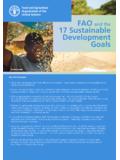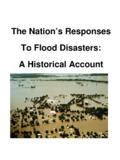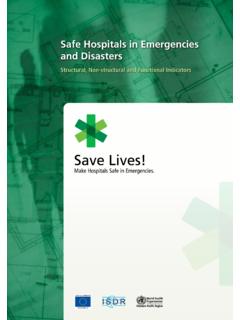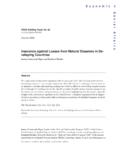Transcription of Communicable diseases following natural disasters
1 WHO/CDS/NTD/ Communicable diseases following natural disasters Risk assessment and priority interventions Programme on Disease Control in Humanitarian Emergencies Communicable diseases Cluster World Health Organization 2006 All rights reserved. The designations employed and the presentation of the material in this publication do not imply the expression of any opinion whatsoever on the part of the World Health Organization concerning the legal status of any country, territory, city or area or of its authorities, or concerning the delimitation of its frontiers or boundaries. Dotted lines on maps represent approximate border lines for which there may not yet be full agreement.
2 The mention of specific companies or of certain manufacturers products does not imply that they are endorsed or recommended by the World Health Organization in preference to others of a similar nature that are not mentioned. Errors and omissions excepted, the names of proprietary products are distinguished by initial capital letters. All reasonable precautions have been taken by the World Health Organization to verify the information contained in this publication. However, the published material is being distributed without warranty of any kind, either express or implied. The responsibility for the interpretation and use of the material lies with the reader. In no event shall the World Health Organization be liable for damages arising from its use.
3 Further information is available at: NTD Information Resource Centre World Health Organization 1211 Geneva 27 Switzerland Fax: (+41) 22 791 4285 E-mail: or Web site: Communicable diseases following natural disasters : risk assessment and priority interventions Contents Acknowledgements ..iv Introduction .. 1 1. Assessing the risk of Communicable diseases Epidemic and endemic diseases associated with natural disasters Waterborne diseases Communicable diseases associated with crowding Vector-borne diseases Other diseases associated with natural disasters disaster -related disruptions 2. Dead bodies and the risk of Communicable diseases 3. Prevention of Communicable diseases following natural disasters Safe water, sanitation, site planning Primary health-care services Surveillance/early warning system Immunization Prevention of vector-borne diseases 4.
4 disaster preparedness plans and control of Communicable disease References Appendix 1: Additional WHO information Communicable diseases following natural disasters : risk assessment and priority interventions Acknowledgements Edited by John Watson, Maire Connolly and Michelle Gayer of the WHO Programme on Disease Control in Humanitarian Emergencies, Communicable diseases Cluster. Key contributions were made by Pamela Mbabazi (CDS/NTD), Jorge Castilla (CDS/NTD), Andre Griekspoor (DGO/IOS), Frits de Haan (FCH/CAH), Jos Hueb (SDE/PHE), Dominic Legros (CDS/EPR), David Meddings (CDS/NMH), Mike Nathan (CDS/NTD), Aafje Rietveld (HTM/GMP), Alice Croisier (CDS/EPR) and Peter Strebel (FCH/IVB).
5 This document was developed by the Communicable diseases Working Group on Emergencies (CD-WGE) at WHO/HQ. CD-WGE provides technical and operational support on Communicable disease control to WHO regional and country offices, ministries of health, other United Nations agencies, and nongovernmental and international organizations. The working group includes the departments of Epidemic and Pandemic Alert and Response (EPR), Neglected Tropical diseases (NTD), Global Malaria Programme (GMP), Stop TB (STB), HIV/AIDS (HIV), Child and Adolescent Health and Development (CAH), Immunization, Vaccines and Biologicals (IVB), Sustainable Development and Healthy Environments (SDE) and Health Action in Crises (HAC).
6 Communicable diseases following natural disasters : risk assessment and priority interventions Introduction natural disasters are catastrophic events with atmospheric, geologic and hydrologic origins. They include earthquakes, volcanic eruptions, landslides, tsunamis, floods and drought. natural disasters can have rapid or slow onset, and serious health, social and economic consequences. During the past two decades, natural disasters have killed millions of people, adversely affecting the lives of at least one billion more people and resulting in substantial economic damage (1). Developing countries are disproportionately affected because of their lack of resources, infrastructure and disaster preparedness systems.
7 The potential impact of Communicable diseases is often presumed to be very high in the chaos that follows natural disasters . Increases in endemic diseases and the risk of outbreaks, however, are dependent upon many factors that must be systematically evaluated with a comprehensive risk assessment. This allows the prioritization of interventions to reduce the impact of Communicable diseases post- disaster . The Communicable diseases Working Group on Emergencies (CD-WGE) at WHO/HQ has developed this document to describe the Communicable disease risks in populations affected by natural disasters . It is hoped that this document, by detailing the priority measures that are necessary to reduce the impact of Communicable diseases following natural disasters , will help to protect the health of disaster -affected populations.
8 Communicable diseases following natural disasters : risk assessment and priority interventions 1. Assessing the risk of Communicable diseases Communicable diseases associated with natural disasters The sudden presence of large numbers of dead bodies in disaster -affected areas can heighten expectations of disease outbreaks (2), despite the fact that dead bodies do not pose a risk of outbreaks following natural disasters (3). Rather, the risk of outbreaks is associated with the size, health status and living conditions of the population displaced by the natural disaster . Crowding, inadequate water and sanitation, and poor access to health services, often characteristic of sudden population displacement, increase the risk of Communicable disease transmission (4).
9 Although the overall risk of Communicable disease outbreaks is lower than often perceived, the risk of transmission of certain endemic and epidemic-prone diseases can increase following natural disasters . Waterborne diseases Diarrhoeal disease outbreaks can occur following contamination of drinking-water, and have been reported following flooding and related displacement. An outbreak of diarrhoeal disease post flooding in Bangladesh in 2004 involved more than 17 000 cases, with the isolation of Vibrio cholerae (O1 Ogawa and O1 Inaba) and enterotoxigenic Escherichia coli (5). A large (>16 000 cases) cholera epidemic (O1 Ogawa) in West Bengal in 1998 was attributed to preceding floods (6), and floods in Mozambique in January March 2000 led to an increase in the incidence of diarrhoea (7).
10 The risk of diarrhoeal disease outbreaks following natural disasters is higher in developing than in developed countries (8). In Aceh Province, Indonesia, a rapid health assessment performed in the town of Calang two weeks after the December 2004 tsunami found that 100% of the survivors drank from unprotected wells, and that 85% of residents reported diarrhoea in the previous two weeks (9). In Muzaffarabad, Pakistan, following the 2005 earthquake, an outbreak of acute watery diarrhoea occurred in an unplanned, poorly-equipped camp of 1800 persons. The outbreak involved over 750 cases, mostly adults, and was controlled following the provision of adequate water and sanitation facilities (10).















